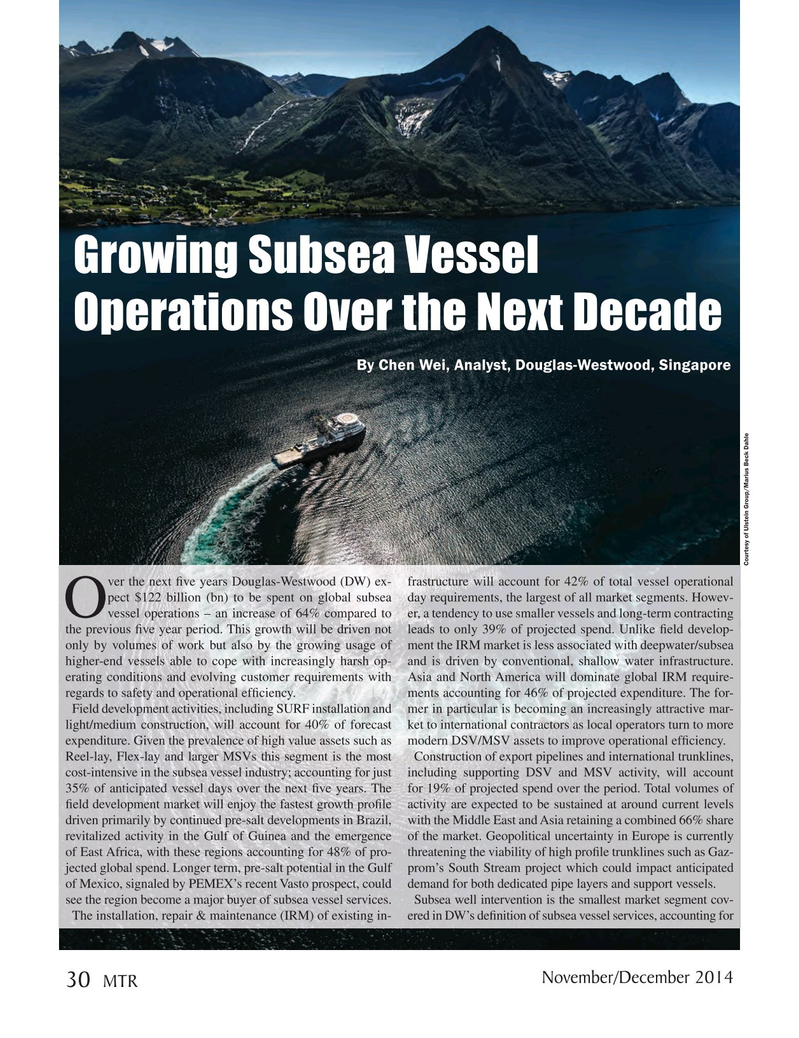
Page 30: of Marine Technology Magazine (November 2014)
Fresh Water Monitoring & Senors
Read this page in Pdf, Flash or Html5 edition of November 2014 Marine Technology Magazine
Growing Subsea Vessel
Operations Over the Next Decade
By Chen Wei, Analyst, Douglas-Westwood, Singapore
Courtesy of Ulstein Group/Marius Beck Dahle ver the next ? ve years Douglas-Westwood (DW) ex- frastructure will account for 42% of total vessel operational pect $122 billion (bn) to be spent on global subsea day requirements, the largest of all market segments. Howev-
Ovessel operations – an increase of 64% compared to er, a tendency to use smaller vessels and long-term contracting the previous ? ve year period. This growth will be driven not leads to only 39% of projected spend. Unlike ? eld develop- only by volumes of work but also by the growing usage of ment the IRM market is less associated with deepwater/subsea higher-end vessels able to cope with increasingly harsh op- and is driven by conventional, shallow water infrastructure. erating conditions and evolving customer requirements with Asia and North America will dominate global IRM require- regards to safety and operational ef? ciency. ments accounting for 46% of projected expenditure. The for-
Field development activities, including SURF installation and mer in particular is becoming an increasingly attractive mar- light/medium construction, will account for 40% of forecast ket to international contractors as local operators turn to more expenditure. Given the prevalence of high value assets such as modern DSV/MSV assets to improve operational ef? ciency.
Reel-lay, Flex-lay and larger MSVs this segment is the most Construction of export pipelines and international trunklines, cost-intensive in the subsea vessel industry; accounting for just including supporting DSV and MSV activity, will account 35% of anticipated vessel days over the next ? ve years. The for 19% of projected spend over the period. Total volumes of ? eld development market will enjoy the fastest growth pro? le activity are expected to be sustained at around current levels driven primarily by continued pre-salt developments in Brazil, with the Middle East and Asia retaining a combined 66% share revitalized activity in the Gulf of Guinea and the emergence of the market. Geopolitical uncertainty in Europe is currently of East Africa, with these regions accounting for 48% of pro- threatening the viability of high pro? le trunklines such as Gaz- jected global spend. Longer term, pre-salt potential in the Gulf prom’s South Stream project which could impact anticipated of Mexico, signaled by PEMEX’s recent Vasto prospect, could demand for both dedicated pipe layers and support vessels.
see the region become a major buyer of subsea vessel services. Subsea well intervention is the smallest market segment cov-
The installation, repair & maintenance (IRM) of existing in- ered in DW’s de? nition of subsea vessel services, accounting for
November/December 2014 30 MTR
MTR #9 (18-33).indd 30 MTR #9 (18-33).indd 30 12/9/2014 11:51:47 AM12/9/2014 11:51:47 AM

 29
29

 31
31
